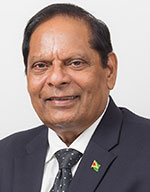THE spotlight this week is on Guyana-China relations, as I wish to share my satisfaction that we have reached a new turning point in the all-round relations between our two friendly countries.
Together with President Granger and several senior government ministers, I attended the simple but solemn ceremony at the Chinese Embassy on Friday last for the signing of a new Memorandum of Understanding (MoU), under what was described as the “Belt and Road Initiative.”
In his remarks, Cui Jianchun, Ambassador of the People’s Republic of China, described the event as an “historic turning point”, and as he said so, my mind raced into history at great events such as the Battle for Stalingrad (1945), the eve of the triumph of the Chinese Revolution (1948) and the patriotic, national liberation counter-offensive in Vietnam (1975), which were described in banner headlines (and later in books) as historic turning points.
It may appear to be an over-dramatisation of the simple signing ceremony, but I am a super optimist that Guyana will not be the same again were we to realise what Vice-President and Foreign Minister Carl Greenidge described as “unplanned consumption” of the many tangible things in the MoU. The up-beat Chinese Ambassador captured it well when he stated that “Guyana has a great future.”
DECLARATORY PRINCIPLES
The inked document itself merely sets out the boundaries and rules of engagement, such as the declaratory principles, “areas of cooperation”, “settlement of differences” and the mandatory, termination provision, over which there could be no excitement. These are the usual legal and diplomatic jargons for which lawyers get handsome fees!
It may be necessary to go beyond the title of cooperation to look at the framework of the “Belt and Road Initiative” under which some $50 billion in development (grant/aid) projects could be accessed by countries such as Guyana. In the longer-run, we could be great, even if we get a small piece of the Chinese pie which is translated in its 2017-2021 profile into US$8 trillion in imports; $750 billion in investment abroad; and 700 million out-bound Chinese tourists.
TARIFF WAR
With the unilateral declaration by the United States of a so-called “tariff war” against China, there would be more than enough room on the shelves of Chinese shops for Guyana’s rice, wood, fish, shrimp, sugar and assorted fruits and vegetables (whole or as value-added products). With some 1.4 billion (1,400,000,000) people, there is no doubt that China could gobble down all of our rum and, of course, all of our gold!
With China reaching the status of a highly developed, prosperous state, Guyana could pursue some of the available transformative projects that could make us both green and great. These would include a modern airport and multiple-lane highways on the coast (now being completed), financing support in private-public partnership arrangements for bridges across the Demerara and Essequibo Rivers, Lethem-Linden-Georgetown highway and a fast train; deep-water Demerara/Berbice harbours; housing schemes and industrial parks that are self-sufficient with clean, renewable solar energy, and high-speed ICT connectivity.
You may say, as John Lennon sang, that I am a dreamer; that none of that would ever happen. But times have changed. Guyana is no longer a mythical story of Cinderella wooing a rich prince, or the beggar maid before King Cophetua.
ON CUSP OF FIRST OIL
Guyana is on the cusp of harvesting first-oil, mere months away, with an untapped reservoir of black gold, estimated at 4 billion barrels. The eyes of the world are now fixed on Guyana, and we have enviable prospects for exponential development. Given the establishment of a Natural Resources Fund (our version of the Sovereign Wealth Fund) our development could be sustainable for future generations.
Today we can look back at the visionary leadership in both the Cheddi Jagan and Forbes Burnham eras, during hostile “cold war” situations, when Guyana defended its reliable and dependable friendship with the People’s Republic of China. In spite of which party had governed, Guyana maintained a “one China” policy. I am confident that this friendship would be consolidated under the coalition government of President Granger.
The Chinese Association and the Guyana-China Friendship Society have also worked silently over the years to build cultural relations that not only maintain the bonds between Guyanese Chinese and their ancestral homeland, but promoted trade and business that have become a dominant feature of commerce and cuisines in Guyana.
PRIDE IN SMALL ROLE
Today, I feel pride, like so many others, in playing a small role both as a government minister and a practising attorney, to bring Guyana and China closer. It started with access by Guyanese to all-day CCTV programmes, training of Guyanese journalists and encouraging Chinese investment in Guyana.
Instead of a garland for my modest efforts, I was maligned (as recently as in 2012) by the then government. The then Trade Minister Manzoor Nadir had falsely accused me of taking a bribe from the Chinese company that was involved in expansion work at the Cheddi Jagan International Airport.
I recall the Guyana Chronicle (17th October, 2012) reporting: “Nadir, holding a picture of Nagamootoo escorting a Chinese delegation from the company that won the bid for the Cheddi Jagan International Airport expansion project, dared the AFC member to challenge allegations of a $10M retainer he got in relation to representation in the particular project.”
I had worked mostly pro bono for those and other Chinese investors whom I had welcomed to my home as friends. I know that one day my family and I could look forward to visiting China, where we have also proverbially built, as the old saying goes, “a home in every town.”




.png)









